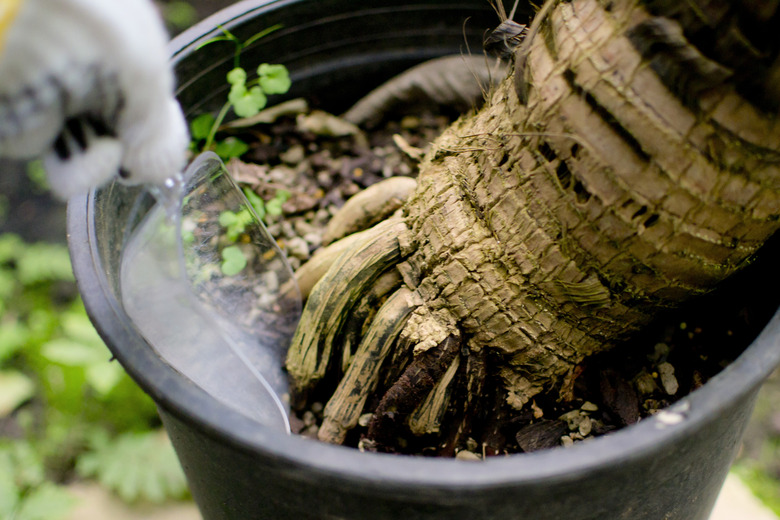Care For Potted Palm Trees
We may receive a commission on purchases made from links.
Proper care for potted palm trees helps your plants thrive and brings the feeling of the tropics indoors. Each variety of palm tree grown as an indoor plant has its own sun, shade and humidity preferences. In coastal areas, potted palm trees can tolerate full sun exposure. In hot desert areas, potted palm trees need protections from full sun. Besides sun, potted palms need some other care to thrive.
Location for Potted Palm Trees
Location for Potted Palm Trees
Specific light requirements can vary based on the palm tree variety, but most palms like bright, indirect light. Choose a spot near a west-facing or south-facing window where the palm can soak up all the brightness without being in the direct light rays. Avoid drafty areas or spots near your heating and cooling vents, which can dry out your palm tree and cause drastic temperature swings.
You can put your potted palm trees outdoors in the warmer months. Wait until there's no danger of frost before putting palm trees outdoors in the spring. Move them back indoors in the fall once the temperature reach 50 to 55 degrees Fahrenheit overnight.
Transplanting Potted Palm Trees
Transplanting Potted Palm Trees
Most potted palm trees do well in the same container for up to two years. As a general rule, palm trees need to be transplanted when the roots are coming out of the pot bottom, the soil becomes compacted or the palm tree becomes too unstable.
When transplanting, a general guideline is to choose a pot that's at most one-third larger than the palm's root ball. Leave at least 6 inches below the rootball for soil and growth. The rim of the pot should be at least 2 to 3 inches above the soil line to leave room for watering. Palm trees need heavy containers to provide stability. If the pot is too lightweight, the palm tree will tip over and may suffer damage.
Watering Potted Palm Trees
Watering Potted Palm Trees
Potted palm trees like high humidity. One way to solve the humidity issue is to place a large tray filled with pebbles under the palm tree. Keep the tray filled halfway with water. Evaporation will create the humidity the palm tree needs. Another way is to mist the palm tree daily.
The best way to determine the watering requirements of the palm tree is through observation. The first time you water your palm, take it outside or to the bathtub and pour water through it until it comes out the bottom. To determine when it needs more water, wait until the soil is dried out to the depth of 1 to 2 inches. Drench with water again.
Flushing the palm tree with water helps prevent the build-up of fertilizer salts in the soil. Salt buildup causes leaf tip burn and the potential death of the palm tree. If you don't water generously and your palm tree is suffering from salt buildup, the only solution is to change the soil in the plant pot.
Fertilizing Potted Palm Trees
Fertilizing Potted Palm Trees
Fertilizer provides nutrition to the palm tree. The best fertilizer for the palm tree is an organic fertilizer like bone meal, blood meal or fish emulsion. Organic fertilizer is slow to release and has less chance to burn the palm tree than inorganic fertilizer. You can also use a fertilizer specifically formulated for palms. Always follow the manufacturer's directions on the fertilizer.
Don't be overly aggressive when fertilizing. It's better to underfertilize a palm tree than overfertilize one. Never fertilize a palm tree in a dry container. Pre-water the growing medium, and don't get any fertilizer on the crown of the plant. To prevent winter growth, don't fertilize during the fall or winter.
Potted Palm Tree Pruning
Potted Palm Tree Pruning
Palm trees need pruning to remove old leaves that have become damaged. Removing too many of the leaves can stunt the growth of the palm tree. Discard the pruning debris because it can harbor plant pathogens.
